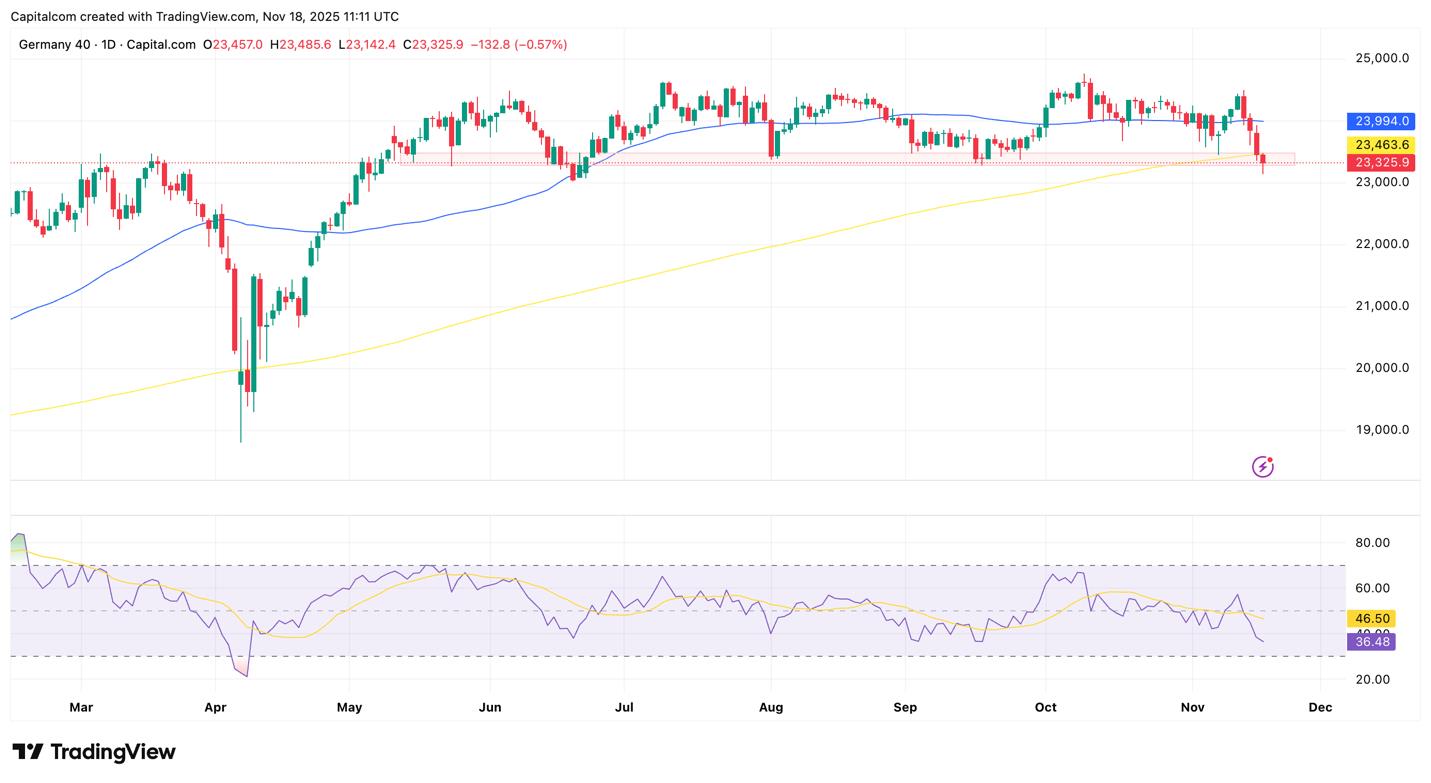
403
Sorry!!
Error! We're sorry, but the page you were looking for doesn't exist.
DAX 40 Outlook: Selloff Continues As Long-Term Support Is Broken
(MENAFN- Mid-East Info) By Daniela Hathorn, senior market analyst at Capital
The DAX is in the midst of a pull-back after recently climbing near its highs, as several headwinds have conspired to dampen investor enthusiasm. Among the most prominent is growing concern about the global growth outlook. Germany's export-heavy economy remains especially vulnerable to weaker demand abroad, and recent data has failed to provide strong reassurance. Meanwhile, valuation pressure is creeping in after a strong run, with the DAX's price-to-earnings multiples remaining elevated by historical standards. Another major factor dragging the index is heightened risk from policy and external shocks. Trade tensions, geopolitics and concerns over central-bank policy reversal are weighing on sentiment. German industrial and auto-oriented firms, which make up a large part of the DAX, are sensitive to disruptions in global supply chains, weaker global manufacturing demand and currency fluctuations. That makes the index more exposed than some other European markets when risk sentiment turns. Technically, too, the market appears to be in a corrective phase. The index has dropped below long-term support around 23,300 after dropping more than 6.5% since the highs in October. The daily RSI is at its lowest point since the April meltdowns which suggests the bearish bias is well-anchored in the short-term direction. The next level of key support could be 23,030 before the index could drop below 23,000 for the first time since May. DAX 40 daily chart -p fetchpriority="high" decoding="async" class="CToWUd" src="#" width="624" height="342" data-bit="iit" /> Past performance is not a reliable indicator of future results. Essentially, investors in the DAX are adopting a more cautious stance, adapting to the changing sentiment in global equities as they adapt to an evolving global economic and rates outlook. Looking ahead, the DAX's next moves will likely depend on several catalysts: clearer signals on German and Euro-area growth data, any shift in the stance of the Federal Reserve, and visibility around global demand (especially in China and the U.S.). Until one of those narratives decisively improves, the risk remains that the DAX continues to trade under pressure and remain range-bound or slip further.
The DAX is in the midst of a pull-back after recently climbing near its highs, as several headwinds have conspired to dampen investor enthusiasm. Among the most prominent is growing concern about the global growth outlook. Germany's export-heavy economy remains especially vulnerable to weaker demand abroad, and recent data has failed to provide strong reassurance. Meanwhile, valuation pressure is creeping in after a strong run, with the DAX's price-to-earnings multiples remaining elevated by historical standards. Another major factor dragging the index is heightened risk from policy and external shocks. Trade tensions, geopolitics and concerns over central-bank policy reversal are weighing on sentiment. German industrial and auto-oriented firms, which make up a large part of the DAX, are sensitive to disruptions in global supply chains, weaker global manufacturing demand and currency fluctuations. That makes the index more exposed than some other European markets when risk sentiment turns. Technically, too, the market appears to be in a corrective phase. The index has dropped below long-term support around 23,300 after dropping more than 6.5% since the highs in October. The daily RSI is at its lowest point since the April meltdowns which suggests the bearish bias is well-anchored in the short-term direction. The next level of key support could be 23,030 before the index could drop below 23,000 for the first time since May. DAX 40 daily chart -p fetchpriority="high" decoding="async" class="CToWUd" src="#" width="624" height="342" data-bit="iit" /> Past performance is not a reliable indicator of future results. Essentially, investors in the DAX are adopting a more cautious stance, adapting to the changing sentiment in global equities as they adapt to an evolving global economic and rates outlook. Looking ahead, the DAX's next moves will likely depend on several catalysts: clearer signals on German and Euro-area growth data, any shift in the stance of the Federal Reserve, and visibility around global demand (especially in China and the U.S.). Until one of those narratives decisively improves, the risk remains that the DAX continues to trade under pressure and remain range-bound or slip further.

Legal Disclaimer:
MENAFN provides the
information “as is” without warranty of any kind. We do not accept
any responsibility or liability for the accuracy, content, images,
videos, licenses, completeness, legality, or reliability of the information
contained in this article. If you have any complaints or copyright
issues related to this article, kindly contact the provider above.


















Comments
No comment